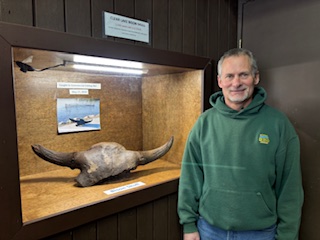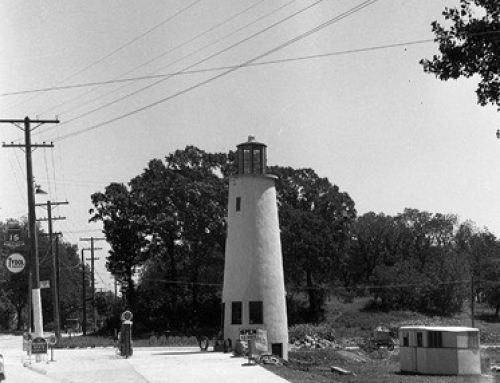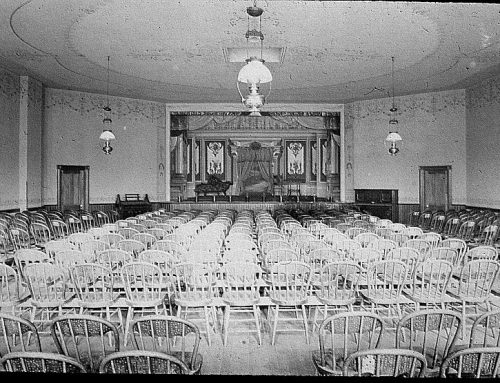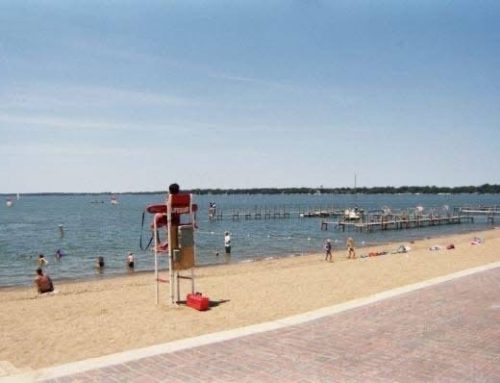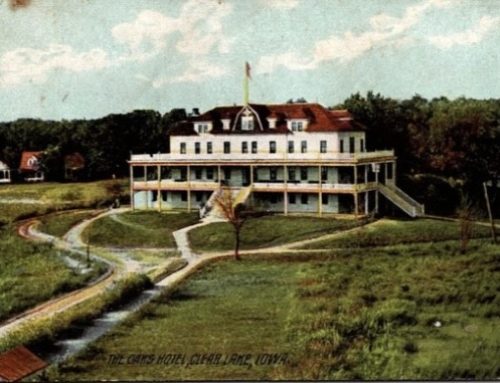This history segment is brought to you by the Clear Lake Public Library History Room. More stories about our past are waiting here for you to discover them.
In recent years Clear Lake has undergone substantial revitalization projects to restore her good name. Multiple groups and countless activists joined together to bring back the Clear. One of those initiatives was dredging over 2.3 million cubic yards of silt from the western “little lake”. The depth went from about 6 foot to the original 28 feet.
Scott Grummer, Iowa DNR Fisheries Management Biologist, believes the removal of this silt was a factor in the discovery of a wonderful secret that was previously buried in the silt. In 2018 the DNR contracted with a commercial fisherman to remove rough fish from the lake. That fisherman snagged the horn of a well preserved bison head while bringing up his nets.
Scott wanted to share this incredible find with others. He posted a photo of it on the DNR facebook page. Amanda Subalusky, PHD, saw that photo. She was then a professor at Yale University with experience in research biology. She reached out to Scott and said she suspected the skull was very old. Was he interested in carbon dating it? She also wanted to test the elemental composition of the skull to find out how it compared to the aquatic mammals she’d been researching.The answer was yes indeed.
Scott carefully removed small bone fragments from the sinus cavity underneath the skull. About a year later Amanda reported back. The skull was discovered to be between 3575 and 3632 years old according to Lawrence Livermore National Laboratory. Because there were no signs of deep gouging or scratching, the buffalo was thought to have died of natural causes. Hunters wouldn’t have wasted one bit of the precious hide or meat.
WOW! Astonishing!
Let’s consider what the buffalo’s world would have been like. We’ll call him Mr. B.
If Mr B could have traveled across oceans, he might have experienced the Shang Dynasty in early China. He could have gone to the newly built Luxor Temple in Egypt and watched a pharaoh’s crowning ceremony.
Closer to Iowa, his grazing fields were also home to indigenous peoples with rich cultures. Mr B freely roamed the tallgrass prairie.That ecosystem, so vast then, is now the most rare and endangered ecosystem in the world. Mr B’s Clear Lake would have been far more diverse than the cattails and rushes we are familiar with. Grasses as tall as a man and blooming plants would have been plentiful on the marshy prairie. The area we call the little lake was seamlessly joined with the marsh. Rains flooded and dry spells drained this marshy prairie.
Mr B and his friends the Elk enriched these lands by grazing. Their footsteps made holes for the forbs and grasses to flourish in. Mr B deposited the seeds in his droppings. Buffalos love to wallow in the ground. The resulting shallow craters created micro ecosystems that filled when rains came. Plants, insects, small birds and amphibians thrived because of Mr B’s wallowing. Even Mr B’s decomposing body supplied the soil with nitrogen and phosphorus.
Mr B’s North American family was estimated to be in the area of 50,000,000 strong. Some estimates are even higher.
Mr B might have wandered across some strange new things in his territory. Grinding stones, mortars and pestle artifacts tell the story of native peoples beginning to transition from mostly hunting and fishing to farming. Farming led to small villages and trade routes. Mr B was revered by these people. He provided food, clothing and shelter. He was an important part of their spiritual lives. They understood the value of living in harmony with the natural world and the importance of carefully protecting the bounty surrounding them.
The new settlers who arrived in the early 1800’s did not necessarily share this respect for the abundant natural resources. Although Clear Lake can be dated back to the Early Pleistocene era (475,000 years ago), it was newly discovered when European settlers moved west across the country.
News of the rich black dirt, plentiful game and beautiful lake traveled back east. By the 1830’s the plow was busy turning over virgin tallgrass prairie and the rich soil beneath into the Corn Belt of today. Early settlers altered the ancestral lands of the natives and Mr B’s descendants. The Sauk, Meskwaki, Ioway, Sioux, Winnebago and Potawatomi became obstacles to the rapid growth of new settlements.
The demand at the time for hides coupled with bounties paid for each buffalo killed created a commercial market that soon outpaced supply. The bison were hunted to near extinction.
Estimates in 1867 put the population at 15 million. A herd of around 5,000 lived where Northwood stands today. By 1885 only 500-800 of the magnificent beasts were left on the continent. The decimation of their bison brought native tribes to their knees.
Ya don’t know what you’ve got till it’s gone.
The tall grass prairie and Bison who once roamed in huge herds have regained their respected place in recent years. Two efforts to restore those treasures are active and available in Iowa. The Neal Smith National Wildlife Refuge and Broken Kettle Grasslands Preserve offer us a glimpse of untouched Iowa.
You can also meet Mr B right here in Clear Lake. Scott Grummer built Mr B his own display home in the DNR building on North Shore Drive. Scott carefully preserved the skull and created a space in the aquarium room for Mr B to safely be on display. Once the building opens this spring, walk past the aquariums to the south east side of the room. He’ll be there waiting for you to discover him. Just turn on the light beside his case and travel back to another era.

